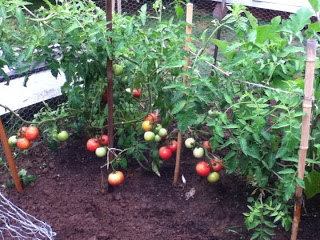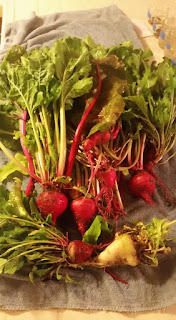If you search the web, you'll find that many gardeners agree on the top easy veggies to grow. We all have our challenges and our favorites.

Last year, my best producer was the
Black Beauty Zucchini.
Some of them grew over 18 inches long
(that's a wide-mouth quart jar for comparison)
You don't have to have a "farm" or land to grow food. If you're up to it, read my recent article "You Don't Need a Farm to Grow Your Own Food."
Just last year we posted about our Bucket Garden Project. "For this project, 100% of the buckets used are recycled. Some of the buckets were from previous projects and the yellow ones once held fresh kitty litter. The white buckets are food grade. The goal of this project to spend as little as possible and still grow food."
For simple seed starting, see our tutorial on
So let's get started!
People often ask, "What's the easiest veggie to grow?" For me, that's a tough one. If I had to choose just ONE, the easiest veggie with the best yield, it would have to be Swiss Chard. Swiss Chard is easy to grow from seed and provides continual harvest for several months after maturity. Swiss Chard can survive warm and hot climates so that's a plus.
What are the 9 Easiest Veggies to Grow?
Planting:
Soak seeds overnight in water before planting to ensure strong germination. Plant seeds half an inch deep and 3 inches apart. Set out seedlings 12 inches apart. Indoors or out, thin newly germinated seedlings with cuticle scissors instead of pulling them out. Chard seed capsules often contain two or more seeds. If more than one germinates, promptly snip off all but the strongest sprout at the soil line
Harvesting:
Twist off individual outer leaves and compost old leaves that have lost their glossy sheen. Three to five leaves can be picked from mature plants at a time, but be sure to leave the growing crown intact.
 |
| CHARD growing in a container |
Radishes are a cool weather crop best planted in spring and autumn. Growing radishes during the hot summer months will cause them to bolt.
Planting: When preparing the planting bed, loosen the soil 6 to 10 inches deep, and mix in good compost or well-rotted manure. Sow seeds a half inch deep and 1 inch apart, in rows spaced 12 inches apart. After the seedlings appear, thin salad radishes to 3 inches apart; thin oriental radishes to 8 to 10 inches apart.
Harvest: Some Radish varieties such as Early Scarlet Globe radish can mature in as few as 22 days!
 |
| RADISH is a quick growing veggie! |
From Mary's Blog:
Planting: All types of lettuce grow best when the soil is kept constantly moist, and outside temperatures range between 45 and 75 degrees Fahrenheit.
Prepare your planting bed by loosening the soil to at least 10 inches deep. Mix in an inch or so of good compost or well-rotted manure. Sow lettuce seeds a quarter of an inch deep and 1 inch apart in rows or squares, or simply broadcast them over the bed.
Harvest: Harvest lettuce in the morning, after the plants have had all night to plump up with water.
 |
| LETTUCE is a great container vegetable |
For the sake of simplicity, I classify beans in 2 categories: Bush and Pole.
Bush beans are usually compact and grow close to the ground. Pole beans climb and require a trellis or other support. Bush beans tend to produce more beans in a shorter time, while pole beans will produce more over an entire season. Pole beans typically require much less.
Planting: Wait until well after the last frost before you plant the beans as they all like warm soil for germination. Plant the seeds about an inch below the surface and keep watered until the seed germinate
Harvest: Whether you grow pole beans or bush beans you will have an abundant harvest if you remember to pick regularly. Most beans are harvested before the seed grows too large, and the overall harvest will continue for many weeks if the beans are picked every day or so.
 |
| BEANS are one of my favorite! |
From Mary's Blog:
Planting: In the spring, sow carrot seeds in fertile, well-worked soil about two weeks before your last frost date. In cool climates, continue planting every three weeks until midsummer. Sow your seeds about a quarter inch deep and 2 inches apart, in rows spaced at least 10 inches apart; carrots do well in double or triple rows. Thin seedlings to 4 to 6 inches apart, depending on the variety’s mature size.
Harvesting: Pull or dig spring-sown carrots when roots reach mature size and show rich color. Summer-sown carrots that mature in cool fall soil can be left in the ground longer, but should be dug before the ground freezes to preserve their quality
From Mary's Blog:
There are two types of cucumbers: slicing and pickling. Each type comes in several different varieties. The slicing types are long and usually grow to about 6 or 8 inches in length while the pickling types are shorter, reaching around 3 to 4 inches once mature.
Planting: Thoroughly water the soil before planting seeds half an inch deep and 6 inches apart. When the seedlings have three leaves, thin them to 12 inches apart, which is the spacing you should use if transplanting seedlings.
Harvest: To maximize production, harvest fruits as soon as they reach picking size. Pick daily, because under ideal conditions, cucumber fruits can double in size in just one day. Use scissors or small shears to snip fruits with a short stub of stem attached.
From Mary's Blog:
The two main things you can do to keep your summer squash plants healthy and productive are to provide plenty of water and to fertilize regularly. Water your plants when the top inch of soil is dry (test by poking your finger into the soil) and then, water deeply and gently so the water percolates down into the soil
Planting: Soak seeds in water for 24 hours before planting to ensure strong germination. Direct seed ½ to 1 inch deep into hills or rows.
Harvest: Harvest zucchini squash when the fruits are small. This will result in a more tender and flavorful squash.
 |
| Last year some of our ZUCCHINI grew HUGE! |
From Mary's Blog:
There are two basic Types of Tomatoes: Determinate and Indeterminate.
Determinate tomatoes produce the fruit all at once. These are typically bush tomatoes, and make the best tomatoes for container gardening. Since all the tomatoes are ripe within a short period of time, these are great plant choices if you plan to can or have a short tomato growing season.
Indeterminate tomatoes grow on a vine. If properly cared for, will produce all season until the first frost.
For indoor seed starting: Start seeds indoors under bright fluorescent lights in early spring, about six to eight weeks before your last spring frost
Soak seeds in water for 24 hours before planting to ensure strong germination. Sow seeds 1/4 inch deep and gently cover with soil
The easiest way to grow tomatoes from seed is to plant seeds in small containers. Tomato seeds usually germinate in 5-14 days. Once seedlings are 4-8 inches tall, transplant into a 5-gallon container/bucket or into your garden.
From Mary's Blog:
Easy-to-grow beets do double-duty in the kitchen, producing tasty roots for baking, boiling or sautéing and fresh greens to boil or steam.
Planting: Begin planting beet seeds directly in the garden one month before your last spring frost date, followed by a second planting two to three weeks later. Beet seeds can germinate in cool soil, but they sprout best when soil temperatures are above 50 degrees
Start planting beets for fall harvest 10 to 12 weeks before your expected first fall frost.
Harvest: Beets can be harvested whenever they grow to the desired size. About 60 days are required for beets to reach 1 1/2 inches in diameter
From Mary's Blog:
We hope you have enjoyed yet another informative growing article here at Mary's Heirloom Seeds. If you have additional questions please ask!
Below you will find a list of Helpful Links! *UPDATED*
Current Series: Container Gardening
Seed Starting Tips Series
Organic Pest Control Series:









5 comments
Hi Mary, I am so glad I found your sites. I love your seeds and just made another order a few days ago. And your information and seed sales are awesome. Thank you for all your hard work. God bless from Montana.
Great info! Going to try these.
I have just put several seedlings of your sunflowers in the garden. They sprouted really quickly and seem to be happy. Can’t wait to see the flowers.
Thanks for all your hard work to help us! We love your videos and blog. You’ve helped our family more than you realize 😊
We enjoy those veggies too… and this morning, I had peas for breakfast! :) I picked a few pods and ate the peas from them fresh in the garden… that is my favorite way to enjoy fresh peas. :)